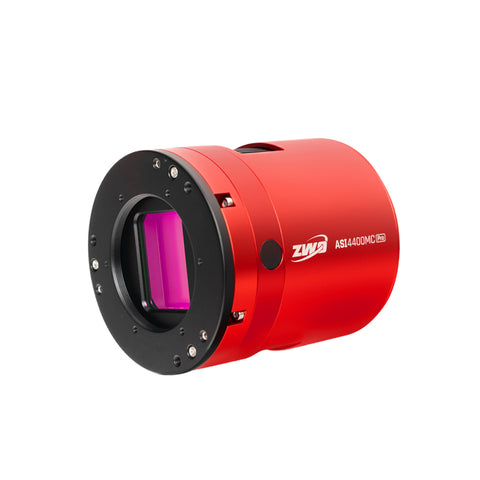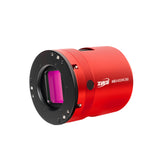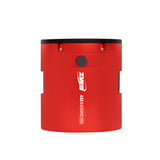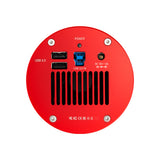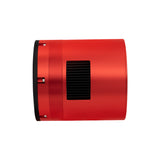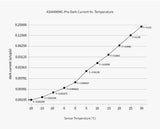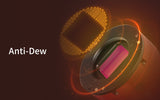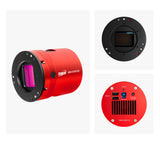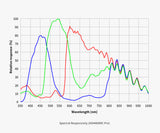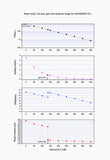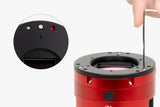![]() Qualifies for Free Ground Economy Shipping (CONUS Only)
Qualifies for Free Ground Economy Shipping (CONUS Only)


 Full-Frame Products Comparison
Full-Frame Products Comparison
The ASI4400MC Pro is the latest addition to ZWO’s full-frame deep-sky camera lineup.
Positioned between the ASI6200MC Pro and the ASI2400MC Pro, the ASI4400MC Pro strikes the perfect balance between image quality and efficiency, giving users a versatile option within the full-frame lineup.
Comparison Table:

Full-Frame for a wider field of view
The ASI4400MC Pro uses a full-frame, back-illuminated sensor measuring 36 × 24 mm with a 43.3 mm diagonal. With 44 megapixels and 4.4 μm pixels, it delivers incredible resolution and light sensitivity in every shot. The full-frame format lets you capture the entire field your optics can deliver - no cropping, no lost edges - perfect for wide-field targets and large deep-sky objects. Each pixel supports a full-well capacity of 74,600 electrons, providing exceptional dynamic range. Bright stars retain their natural color and detail, while faint nebula structures and galaxy arms remain beautifully visible. The result is cleaner, more balanced images with outstanding tonal depth across the frame.


High Dynamic Range, Capturing Both Highlights and Faintest Details
The ASI4400MC Pro features a 14-bit analog-to-digital converter (ADC) that delivers a dynamic range of over 13 stops. This wide range allows a single exposure to capture both bright highlights and faint shadow details without clipping. Whether you’re imaging bright stars, nebula cores, or the delicate wisps of distant galaxies, more tonal information is preserved for smoother gradients and richer color depth. The result is a natural, well-balanced image straight out of the camera, with plenty of flexibility for post-processing and fine-tuning.

Efficient Cooling, Protecting Image Quality
The ASI4400MC Pro uses a powerful two-stage TEC cooling system capable of lowering the CMOS sensor temperature by 30°C to 35°C below ambient. This deep cooling dramatically reduces dark current and thermal noise, keeping your images clean and smooth - even during long exposures that last several minutes. The result is higher signal-to-noise ratio and improved image quality in every frame.
Note: Cooling performance varies with ambient temperature. The lower the ambient temperature, the smaller the achievable differential. Results are based on tests at 30°C ambient. Operation below -20°C is not recommended.


Glow Suppression Function*
The ASI4400MC Pro camera features ZWO’s proprietary Glow Suppression technology, which effectively controls sensor glow and maximizes overall imaging performance. This technology is implemented directly at the hardware level and does not require any software intervention.
*While Glow Suppression significantly reduces CMOS sensor glow, it does not eliminate it entirely. A small amount of glow may still be present; however, with dark-frame calibration, it has no impact on the final image quality.

USB 3.0 & 512MB DDR3 Memory
The ASI4400MC Pro includes a high-speed USB 3.0 interface with a built-in 512 MB DDR3 memory buffer. This design ensures fast and stable data transfer while reducing the risk of dropped frames or transmission errors. The result is reliable image capture, even during long exposures or high-speed downloads.

Anti-dew
The ASI4400MC Pro features a built-in polyimide heater bonded to the protective window to prevent dew and frost buildup, ensuring clear and reliable imaging throughout the night.
- The heater draws about 5 watts of power and can be turned off through the software when conditions allow, not only to save power but also to reduce the load on USB hubs and external power supplies.

Sensor Tilt Adjustment
The ASI4400MC Pro includes three sets of sensor tilt adjustment screws. Each set has a push and a pull screw that let you fine-tune the sensor’s alignment with your telescope’s optical axis. This adjustment helps correct any slight tilt that can cause stars to appear elongated or out of focus toward the edges of the frame, ensuring sharp, even focus across the entire image.

Camera Performance
The ASI4400MC Pro offers a dynamic range of up to 13 stops, allowing it to capture both bright highlights and faint shadow details in a single exposure. This wide range is key to achieving high dynamic range (HDR) performance, preserving fine tonal transitions and subtle color detail in deep-sky images. When the gain setting reaches 136, the camera automatically activates HCG (High Conversion Gain) mode, which greatly reduces read noise while maintaining full dynamic range. This means you can increase sensitivity for faint targets without adding unwanted gain noise, making it easier to capture clean, detailed images under a variety of conditions.

QE Value
The QE peak value of the ASI4400MC Pro camera is 80%.

Ultra-low Dark Current
Thanks to the ASI4400MC Pro’s advanced cooling system, thermal noise remains extremely low even during long exposures lasting several minutes. Dark current is a small electrical signal created by heat inside the sensor rather than by incoming light. By keeping the sensor temperature low, the camera minimizes this effect, producing cleaner, higher quality images with smoother backgrounds.

UV-IR Cut Filter
The ASI4400MC Pro is equipped with a UV-IR cut filter mounted in front of the sensor. This protective filter blocks unwanted ultraviolet and infrared light that can cause star bloat and color distortion, allowing only visible wavelengths to reach the sensor. By filtering out these non-visible wavelengths, the camera produces sharper stars, more accurate colors, and overall improved image quality in astrophotography.

Product Details
- Lightweight Body: 700g
- Interface Layout: USB 2.0, USB 3.0, DC
- Fan Position & Heat Dissipation Vents
- All-Metal Red Body

Connection Method

Mechanical Diagram

What's in the box?

Note:
External power supplies are needed for all ASl-cooled cameras. We recommend you use a 12V@3A~5A DC adapter (D5.5×2.1mm, center pole positive) or a lithium battery with 11-14V to power the camera. If the voltage exceeds this range, the camera will activate its automatic protection mechanism.

